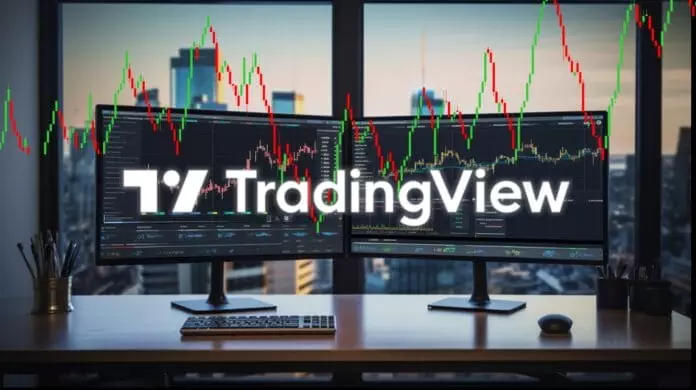Greetings! As an experienced day trader, I’m eager to assist you in configuring TradingView to cater to your daily or intraday trading requirements. Its potent analytical features and alert mechanisms have revolutionized my trading journey completely. Let’s delve into the ways we can enhance TradingView to suit your day trading needs.
Let’s delve into customizing chart situations, incorporating alerts, and harnessing its top-notch features. Let’s optimize your trading experience together!
Key Takeaways
- TradingView offers various technical analysis tools, including hundreds of pre-built studies, intelligent drawing tools, and popular indicators.
- Bar Replay and Historical Data features allow users to watch pricing data historically, rewind and review markets at desired speed and resolution, and simulate trading on historical data.
- TradingView provides testing and strategy development capabilities, allowing users to simulate real trading on charts, test ready-made or self-written strategies, and access detailed reports on strategy performance.
- The platform offers powerful and flexible trading alerts or updates, cloud-based updates available on any device, and various update conditions for indicators, drawings, strategies, and Pine Script™ updates.
Introduction to TradingView for Day Trading
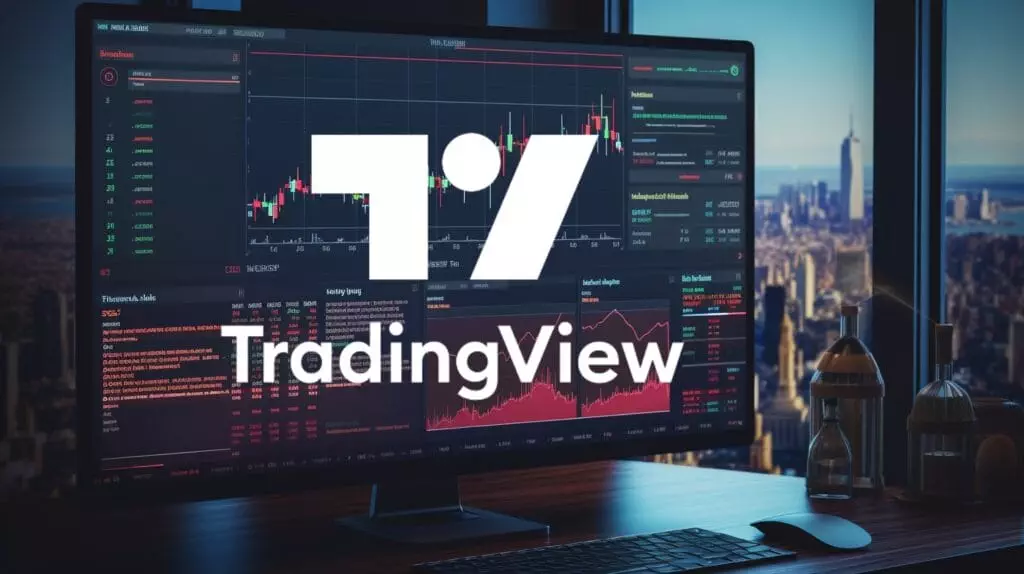
As we embark on our journey to understand TradingView for Intraday trading trading, we’ll first uncover the power of this tool.
We’ll navigate its key features and functions, helping you grasp what makes it a preferred choice for many traders.
Lastly, I’ll guide you on setting up your TradingView account for optimal performance, ensuring you’re ready to hit the ground running.
Discovering the Power of TradingView as a Day Trading Tool
I’m about to dive into the fascinating world of TradingView, a powerful tool for day or intraday trading that offers many features and capabilities.
It’s not just a platform; it’s a community of traders sharing insights and strategies. To configure TradingView for maximum effectiveness, you’ll need to understand its potential fully.
This Intraday trading tool is more than just charts and graphs; it’s a hub of information that can inform your trading decisions. With TradingView, I can access real-time data, comprehensive analysis tools, and a vibrant community of traders.
It’s a tool that empowers me to make informed, strategic decisions about my trades.
Navigating the Key Features and Functions of TradingView
So, we’ve covered the basics of TradingView. Now it’s time to delve deeper into the key features and functions that make this platform a must-have for intraday trading.
- Charting Tools: TradingView is a charting platform that offers diverse charting tools, providing traders with a comprehensive analysis platform.
- Technical Indicators: With over 100 pre-built indicators, you can use TradingView to spot trends and predict market movements.
- Trading Alerts: Stay updated with market changes through TradingView’s real-time alerts system.
- Paper Trading: Practice your strategies risk-free before putting real money on the line.
With this TradingView tutorial, I hope you find it easier to navigate and use TradingView for your intraday trading adventures.
Setting Up Your TradingView Account for Optimal Performance
Before setting up your TradingView account for optimal performance, let’s take a moment to understand why it’s crucial for your intraday trading success.
A well-configured account ensures smoother operations, quicker analysis, and more successful trades. When setting up your TradingView account for optimal performance, you’re setting the stage for streamlined intraday trading experiences.
In learning how to set up TradingView for intraday trading, configuring your account is the first step. This involves adjusting settings to suit your trading style, setting up alerts for market movements, and customizing your charts for easy analysis.
Customizing Your TradingView Chart Settings for Day Trading
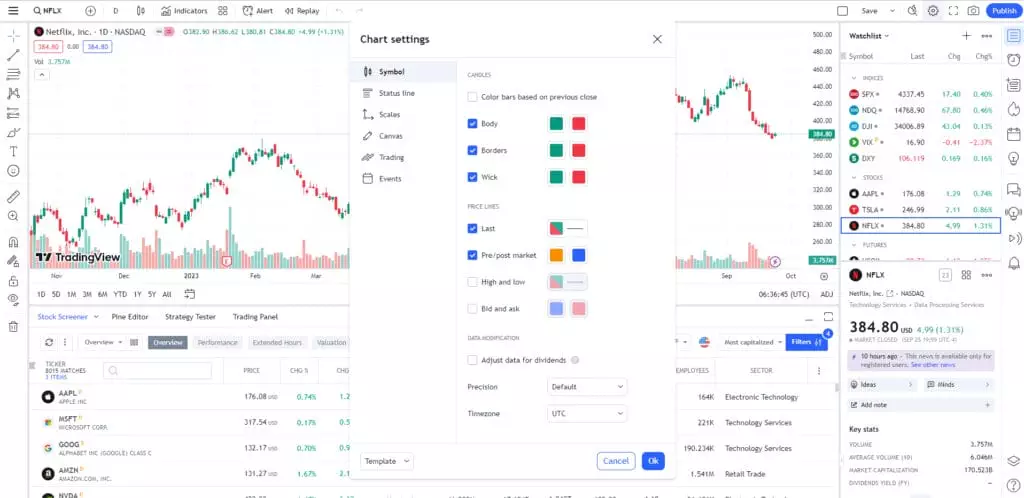
Now, let’s customize your TradingView chart setup or settings for intraday trading.
We’ll start by picking the perfect chart form for your strategies, then move on to adjusting timeframes and chart setups to complement your trading style.
Choosing the Ideal Chart Types for Your Day or Intraday Trading Strategies
I will walk you through selecting the perfect chart type from the hundreds available on TradingView and tailoring them to suit your intraday trading plans. Setting up your charts is a straightforward process customizable to your needs.
- Candlestick Charts: These offer detailed information about price movements, ideal for short-term trades.
- Bar Charts: These give a simple overview of price movements, perfect for a glance.
- Line Charts: Great for identifying trends over time. These are best for longer-term strategies.
- Area Charts: These highlight price changes over time, showing overall performance.
Adjusting Timeframes and Chart Settings to Match Trading Style
In this section, we’ll cover how to adjust the timeframes on your TradingView charts and tweak other settings to perfectly align with your intraday trading style. Adjusting timeframes and chart setups to match trading style is crucial to setting up TradingView for intraday trading effectively.
| Key Setting | How to Adjust |
|---|---|
| Timeframes | Click on the clock icon at the top and select your preferred timeframe. |
| Chart Type | Choose from line, bar, or candlestick chart types to best fit your trading style. |
| Indicators | Click the 'f' icon to add or remove indicators. |
| Drawing Tools | Use the pencil icon to select your preferred drawing tool for marking trends and patterns. |
Saving Your Customized Chart Setups or Settings for Future Use
Often, I find myself customizing charts to suit my intraday trading preferences, and it’s essential to know how to save these settings for future use.
TradingView for intraday trading offers a handy feature to save your chart setups. It’s quite simple and can save you time in the long run.
- After adjusting the chart to your preference, click the ‘chart layout’ button.
- Select ‘Save As’ and provide a name for your customized settings.
- The next time you want to apply these settings, click the ‘chart layout’ button again.
- Select your saved layout from the dropdown menu.
Incorporating Indicators and Alerts into Your TradingView Setup
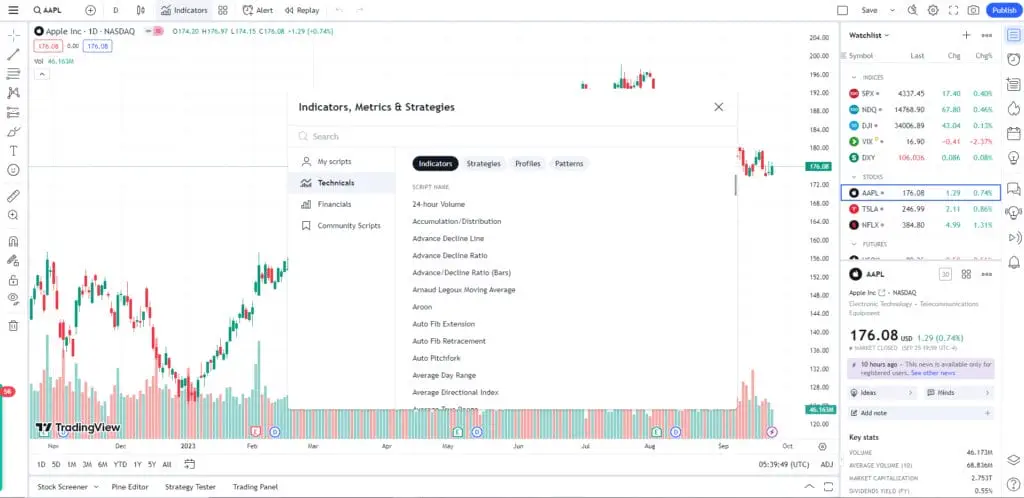
Let’s enhance our TradingView setup by adding key indicators and alerts.
Indicators such as MACD, RSI, and Stochastics can provide useful insights for intraday trading, and alerts help us keep track of price movements and indicators without constant monitoring.
We’ll also look at how to leverage features like Rockwell PowerX to boost our trading efficiency.
Adding Essential Indicators such as MACD, RSI, and Stochastics
I will show you how to add essential indicators like MACD, RSI, and Stochastics into your TradingView setup, significantly enhancing your ability to make informed intraday trading decisions.
- MACD (Moving Average Convergence Divergence): This technical indicator helps identify potential buy and sell signals.
- RSI (Relative Strength Index): RSI measures the speed and change of price movements, providing insights into overbought or oversold conditions.
- Stochastics: This momentum indicator compares a particular closing price to a range of prices over a certain period.
- Alerts: Setting up alerts for these indicators can be a game-changer, notifying you of significant market moves.
Mastering these tools will give you a competitive edge in the market.
Configuring Alerts to Keep Track of Price Movements and Indicators
Incorporating alerts into my TradingView setup is the next step, allowing me to monitor price movements and indicators effectively. By configuring alerts to keep track of price movements and indicators, I can stay ahead of the game, making informed decisions based on real-time data.
Here’s a quick guide to setting an alert:
| Steps | Description |
|---|---|
| 1. Select the 'Alert' icon | This opens the 'Create Alert' dialogue box. |
| 2. Define your alert | Choose the price, indicator, or drawing to monitor. |
| 3. Configure alert options | Set the frequency, expiration, and message for the alert. |
These alerts ensure I take advantage of every potential trade opportunity. Remember, mastery comes with practice. So, keep experimenting with these powerful features of TradingView.
Utilizing Rockwell PowerX and Other Industry-Specific Features
Now, I’ll delve into how to utilize Rockwell PowerX and other industry-specific features in my TradingView setup.
As a day FoRex trader, the right tools on my platform are crucial. Here’s how I incorporate them:
- Rockwell PowerX: I use this for identifying potential trades. It’s efficient and provides a risk/reward calculation.
- Indicators: These help me interpret market trends. I use the RSI, MACD, and Bollinger Bands most frequently.
- Alerts: Setting up alerts keeps me informed about significant price movements. It’s a game-changer for my trading tactic.
- Charting Tools: TradingView’s advanced charting tools offer in-depth market analysis.
Analyzing the Market with TradingView’s Fundamental and Technical Analysis Tools
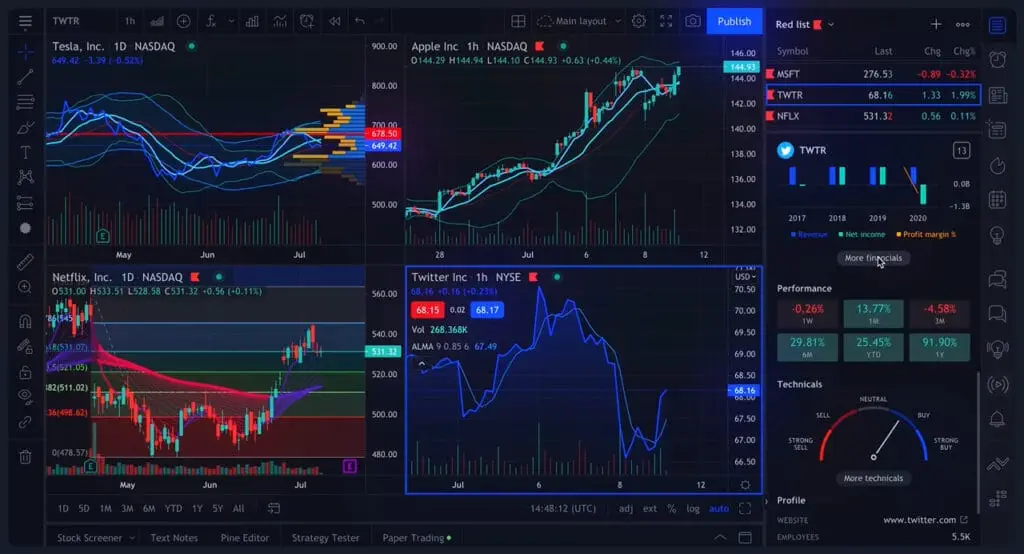
Now that we’ve set up our trading account on TradingView for intraday trading let’s tackle the next crucial step – analyzing the market using TradingView’s fundamental and technical analysis tools. TradingView is an extremely versatile tool for this purpose.
We’ll start by exploring the platform’s inbuilt function for fundamental analysis. As you use the platform, you’ll discover many features tailored for market analysis.
Then, we’ll perform technical analysis with its charting tools and interpret trading signals and trends using its advanced indicators.
Making Use of TradingView’s Inbuilt Function for Fundamental Analysis
I will dive into how to make the most of TradingView’s built-in functions for fundamental analysis, which can be a game-changer in your intraday trading strategy.
To use TradingView charts effectively, consider the following steps:
- Identify Key Indicators: Use TradingView’s inbuilt function for fundamental analysis to identify market trends, price patterns, and trading volumes.
- Apply Technical Analysis: Combine these fundamentals with technical analysis tools to comprehensively understand market behavior.
- Set Alerts: You can set price alerts to keep up with market movements. This is especially useful when you must quickly go to a specific price point.
- Use the Social Network: TradingView provides a platform for sharing trading ideas, which can be a valuable source of information.
Mastering these functions can provide invaluable insights and significantly improve your intraday trading results.
Performing Accurate Technical Analysis with TradingView’s Charting Tools
While it’s essential to understand the fundamentals, we’ll be focusing on how to perform accurate technical analysis using TradingView’s charting instruments in this section. To set up TradingView for intraday trading, I recommend using charting instruments to analyze price trends and patterns, which can give you insights into the market’s current direction and potential future movements.
Here’s a quick breakdown:
| Tool | Use |
|---|---|
| Trend Lines | To identify the direction of the market |
| Volume Indicators | To gauge market interest |
| Moving Averages | To smooth out price fluctuations |
Performing accurate technical analysis with TradingView’s charting instruments can initially seem complex. Still, you’ll see patterns and trends more clearly with practice, improving your intraday trading decisions.
Interpreting Trading Signals and Trends using TradingView’s Advanced Indicators
As we dive deeper into the capabilities of TradingView, it’s important to note that interpreting trading signals and trends using TradingView’s advanced indicators can significantly improve our understanding of the market dynamics. Here’s a simple guide to help you setup TradingView for intraday trading:
- Moving Averages: These indicators can help identify overall market trends. A rising moving average indicates an uptrend, while a falling moving average signals a downtrend.
- Relative Strength Index (RSI): This tool measures the speed and change of price movements. An RSI above 70 typically indicates overbought conditions, while an RSI below 30 suggests oversold conditions.
- MACD: The Moving Average Convergence Divergence (MACD) helps track market momentum and potential buy/sell points.
- Volume: High trading volumes often indicate strong investor interest and can signal the start of a new trend.
Mastering these tools can greatly enhance your trading strategy.
Harnessing TradingView’s Paper Trading and Full-Featured Chart Functions

Now, let’s talk about how to make the most of TradingView’s paper or simulated trading and full-featured chart functions. For those who prefer to trade using comprehensive tools, TradingView is one of the best platforms out there.
We’ll start by exploring how to practice trades using the platform’s simulated trading functionalities. This is the best way to learn and start trading without financial risk.
Then, we’ll see how to use full-featured charts for a comprehensive market perspective. With various time frames and many charts and indicators, you’ll find that the TradingView platform offers everything you need.
And finally, we’ll discuss how to leverage the collaborative aspects of the TradingView community. Many traders use this community to share insights and learn from one another.
Practising Trades with TradingView’s Paper Trading Function
I will explain how to use TradingView for simulated trading, a vital tool every trader should use to practice and perfect their strategies before diving into the real market. As we set up TradingView for intraday trading, this feature allows us to test our strategies with zero risk.
- Start by enabling paper trading: Go to the chart settings and select ‘Trading Panel.’ If you’re new, you can get TradingView through their TradingView website and even opt for a free trial.
- Choose a starting balance: This should ideally mirror what you’d realistically invest. Remember, you can start with a free account and access free data.
- Execute trades: Practice trades using the ‘Buy’ and ‘Sell’ buttons. You can use a different broker integrated with the platform if you wish.
- Monitor your performance: Keep track of your profits and losses to tweak your strategy accordingly. Depending on your preference, You can view one chart at a time or multiple.
Practicing trades with TradingView’s paper or simulated trading function is key to mastering the market dynamics without actual financial risk.
Utilizing the Power of Full-Featured Charts for Broad Market Perspectives
Having discussed the paper or simulated trading function, it’s equally important to delve into the full-featured charts of TradingView, which is an extremely powerful tool. These charts visually represent market activities, helping us make informed decisions.
| Features | Benefits | How it enhances day trading |
|---|---|---|
| Broad market perspectives | Provides an overview of market trends | Helps identify potential profitable trades |
| Real-time data | Ensures up-to-date market information | Aids in making timely decisions |
| Customizable interface | Allows personalization according to needs | Enhances user experience and efficiency |
| Technical indicators | Offers insights on market movements | Enhances analysis for better trade decisions |
| Paper trading | Simulates real trading without risks | Allows practice and strategy testing |
Through the setup of TradingView, an extremely versatile platform, utilizing full-featured charts for broad market perspectives becomes a powerful tool in successful trading.
Tapping into the Collaborative Community Aspects of Trading View Platform
Let’s dive into TradingView’s collaborative community aspects. I can harness the platform’s simulated trading and full-featured chart functions and network with other traders.
The TradingView platform for desktops offers a robust and interactive community, enabling social trading at its finest. Here are some key features:
- Paper or Simulated Trading: This lets me practice strategies without risking real money. It’s a safe space to learn how to trade.
- Full-Featured Charting: With this, I can analyze markets in depth using technical indicators and drawing tools.
- Social Trading: I can follow other traders and brokers, learn from their strategies, and share my insights.
- Community Interaction: Here, I can participate in discussions, ask questions, and network with seasoned traders. It’s the best TradingView feature for those who like TradingView for its community aspects.
Leveraging these resources can significantly improve my trading skills and even introduce me to automated trading options available.
Frequently Asked Questions
What Types of Subscriptions Does Tradingview Offer and What Are Their Benefits?
TradingView offers several subscription plans, including the free version of TradingView, Pro, Pro+, and Premium. Each upgrade provides benefits like more indicators per chart, faster data flow, and priority customer support, enhancing your forex trading and crypto trading experience.
How Can I Share My Charts on TradingView or Strategies on Tradingview’s Social Network?
You can share your trading tactics and different charts on TradingView directly on your profile. This feature allows traders who want to contribute to the community to receive feedback from other TradingView users.
Can I Access Tradingview on Multiple Devices and How Does the Cloud-Based Alert System Work Across These Devices?
Yes, you can use multiple devices to access TradingView. Its cloud-based alert system syncs across all devices, ensuring you never miss an alert, no matter where or what device you use.
Does Tradingview Provide Any Step-by-Step Tutorial or Educational Resources to Help Understand How to Use the TradingView App Effectively for Intraday Trading?
Yes, TradingView provides a comprehensive guide and numerous educational resources, including a step-by-step tutorial to utilize their platform for intraday trading effectively. Many traders may find these tools incredibly helpful in mastering the trading process.
Are There Any Specific Requirements or Guidelines for Writing and Sharing Scripts in Pine Script™?
Yes, there are guidelines for writing and sharing scripts in Pine Script. It’s crucial to ensure your scripts are clear, concise, and accurately depict your trading strategy for others to understand and utilize.
Conclusion
There you have it! By leveraging TradingView’s advanced trading features, you can create a personalized setup perfect for intraday trading, whether it’s stock charts, cryptocurrency trading, or any other form of trading.
Remember to save your chart settings, incorporate relevant custom indicators and alerts, and utilize analysis tools offered by TradingView.
Remember to practice with the paper trading function, which allows you to trade in a simulated trading environment without risking real money.
With the right setup, TradingView is an amazing platform that can significantly enhance your effective trading experience and success. Whether you’re a beginner looking to start using TradingView or an expert wanting to refine your strategies, this platform has something for everyone.
Happy trading!
